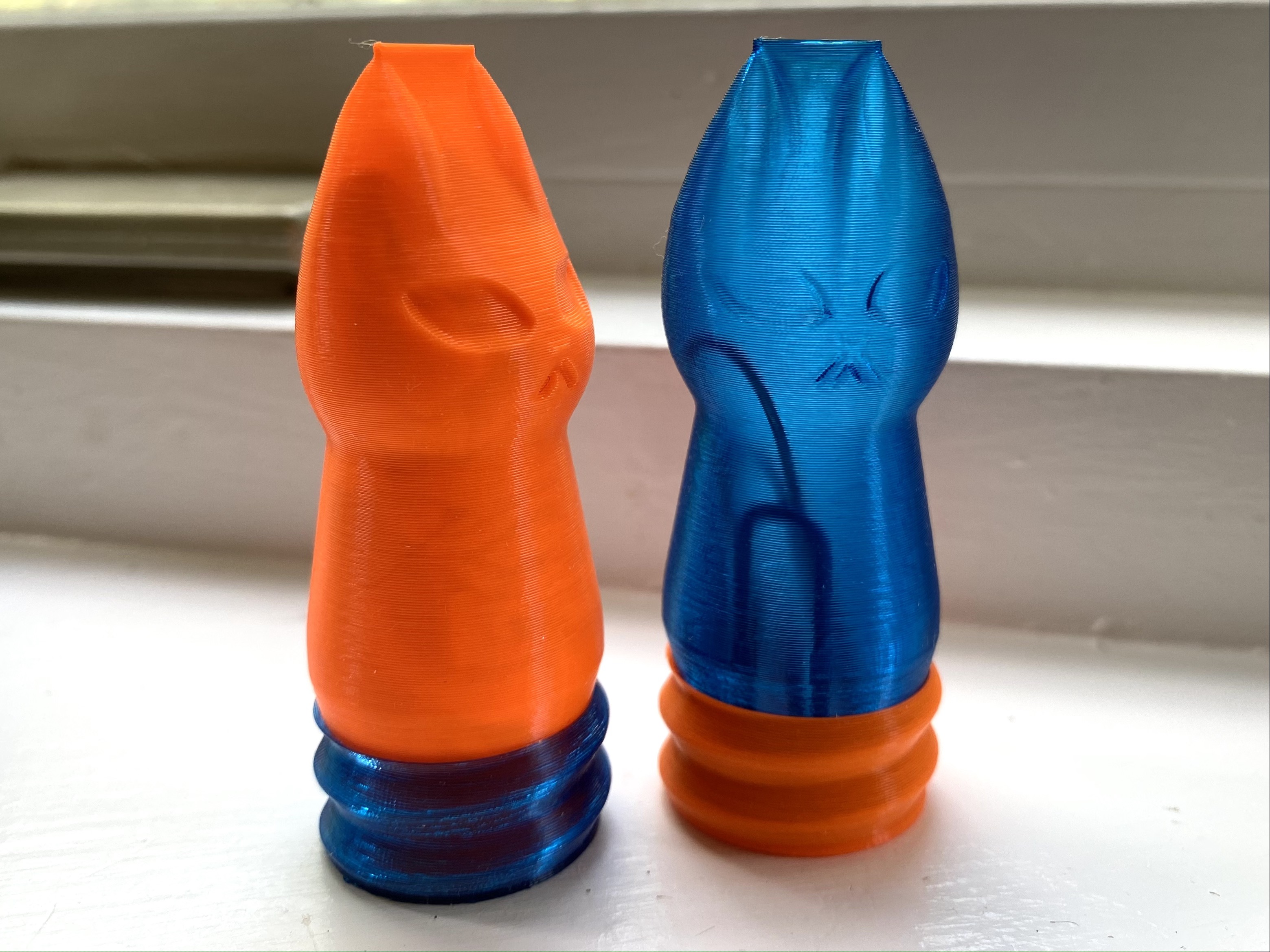
Cattainer - Fast Vase Mode Print
prusaprinters
<figure class="image image-style-align-right image_resized" style="width:50%;"><img src="https://media.printables.com/media/prints/207341/rich_content/7e44ca26-3959-4010-a7cc-bebb922d7678/cattainerbuild.gif#%7B%22uuid%22%3A%22ad414e5e-1f8b-4db8-abd1-a9ff874ff06e%22%2C%22w%22%3A372%2C%22h%22%3A584%7D"></figure><p>A small, quick container shaped like a cat, which prints in spiral vase mode in two parts and uses about 3.5 grams of material. </p><p>Things you could put in a cattainer:</p><ul><li>at least a dozen paper clips</li><li>3d printed clips</li><li>emergency advil supply</li><li>screws</li><li>3 pieces of dry penne pasta</li><li>a microSD to USB stick</li><li>a medium sized scrunchie</li><li>a cool pebble you found</li><li>etc.</li></ul><p>You could also use this as a spiral vase mode calibration print.</p><p>Filaments in photos are Printed Solid Jessie Blue Ice PLA (the lighter blue) and Mystery Orange PLA, and Prusament Ultramarine Blue Transparent PETG (the darker blue.)</p><h4>Printing:</h4><ul><li><strong>Vase mode</strong>: Cattainer is two prints, the main body and the screw-on lid. Both print in spiral vase mode.</li><li><strong>0.4mm nozzle</strong></li><li>0.2mm height is what I tested but others may work</li><li><strong>1.2mm of bottom layers</strong>, e.g. 5 layers of 0.2mm height. This is important because there's a hollow in the bottom of the main cat model, so that it prints open but still has a bit more bed adhesion than a single line.</li><li>PLA and PETG both work; PETG is stronger</li><li>I recommend a wider line width, e.g. 0.45mm</li><li>For PETG, I recommend as high as you can go in its temperature range and no fan</li></ul><h5>Notes and stress testing:</h5><ul><li>Not water tight (but if you can get it that way let me know!)</li><li>A well-printed PLA cattainer, if you squish at it a bunch, will break apart (probably at the neck)</li><li>A well-printed PETG cattainer, if you squish at it a bunch (or outright try to crush it) will crack in places</li><li>Essentially, I wouldn't expect a PLA cattainer to survive extended use in a backpack or purse, but it could float around a drawer or desk space. A PETG cattainer might make it, depending how rough you are with your stuff.</li><li>I'm working on a version that can be printed with a 0.8mm nozzle - a bunch of small details means this version isn't compatible with other nozzle sizes.</li></ul><p>___</p><p><strong>New to vase mode or still learning?</strong></p><ul><li>Spiral vase mode takes the outside wall of a solid, continuous model and calculates a continuous single spiraling path to print to the top. (Usually this is after a few standard solid layers at the bottom.)</li><li>In Prusa slicer, this is the “Spiral vase” option you can check off in Print Settings > Layers and Perimeters. It will automatically change several of your settings to be compatible with the mode.</li><li>In Cura slicer: Special Modes > Spiralize Outer Contour</li><li>To get a good vase mode print, you'll want to refine a couple more settings.<ul><li>PLA: You want to print slow and steady, and at a lower extrusion rate than normal printing. Too much extrusion will get you tiny bumps around your print; too little can make it too fragile and prone to cracking between layers.</li><li>PETG: You'll want to find the right settings for your filament—probably in its upper range for heat and with as little fan as possible—so that the ‘layers’ are well bonded and it doesn't crack apart too easily. So far I've had good results with my extrusion set to 100%.</li></ul></li><li>If you're getting weirdly evenly spaced bumps on the outside, especially if you're on a more basic machine like an Ender 3: a few things can cause this, but most likely, the printer is pausing for a split second to save information to your SD Card, or send information elsewhere, if you use something like OctoPrint. Fixes include:<ul><li>Update your firmware (to Marlin 2.0 if necessary) and change the settings to turn off power failure recovery mode, disallow the printer from writing to the SD card, and turn on arc calculation. (Also make sure your Printer Settings in PrusaSlicer have G-code flavor set to Marlin 2.)</li><li>Using a faster microSD</li><li>Being hardwired to the printer, if you use OctoPrint</li></ul></li></ul>
With this file you will be able to print Cattainer - Fast Vase Mode Print with your 3D printer. Click on the button and save the file on your computer to work, edit or customize your design. You can also find more 3D designs for printers on Cattainer - Fast Vase Mode Print.
